With NZ in Alert Level 4, we have seen a huge increase in reliance on digital services. The one that oddly enough drove it home for me was hearing that people were struggling to buy Lotto tickets online. 75% of ticket sales were previously over the counter.
While Lotto is far from the top of mind, it highlights that there is a gap between the haves and have nots when it comes to technology in everyday life.
What about more important things like being able to browse to the COVID-19 website, shop safely online for essentials, communicate to the outside world, or keep your job and work from home when asked.
The digital divide is about the gap between those who are able to participate in an online, digital-first world, and those who are simply locked out of it. The most pronounced communities impacted are rural, those with low socioeconomic status and the elderly.
So what are some things NZ could have been doing differently?
Think bigger about how we manage the telco industry

We are so lucky to have UFB. The number of businesses that would be facing closure or are so hamstrung by productivity issues that they are totally inefficient would be far higher if this investment had not been made.
Fibre is a great technology for connecting into areas with population density and to fixed abodes. But that leaves a massive gap into rural communities and for families that are much more mobile. That’s before we mention IoT. So why don’t we take similar approaches with mobile that we did with UFB and avoid network overbuild at all costs by creating wholesale models and shared asset bases?
Instead, we auction spectrum, then charge telco levies, only to spend those levies on initiatives like the mobile blackspot fund. We create a money-go-round between the top of the cliff and the bottom. The final 5G spectrum auction will now not occur for two more years - use this time to think about how we can ensure 5G can be a national asset like the UFB networks.
Provide education with core digital services

There is a huge focus from government agencies on digitising their services. This has economic benefits like lowering the cost to serve, while also boosting the service experience. However with each new service available online, what is being done to educate those most at risk of being on the wrong side of the digital divide?
Rather than reinvent the wheel within every agency, an expert agency focused purely on education could provide educational services as a mandatory part of any new service launch.
With a specific focus on age-based, ethnic and economic groups, we can ensure our most vulnerable receive the help they require.
Think about people, not locations

From time to time the government intervenes in the free market. This occurs where there is a failure of the market to provide. We saw this with UFB and Crown Fibre holdings and other initiatives like Network for Learning (which I was involved in). These both provided core infrastructure and equity of access to that infrastructure for schools regardless of location or decile. The thinking now needs to move on beyond connecting schools - I do not believe the same conditions exist today.
The vision needs to move beyond the school gate. This is not a new problem, and should it have been addressed, we would not only have more equitable access to digital learning outside of the classroom, but we could now be leveraging that for people to work from home. The same goes for devices. Think big, that is what systematic intervention is for.
Final thoughts
It is great to see Chorus leading the way by offering 6months free fibre connections into homes for educational purposes. We are seeing other fibre companies following suit and ISPs I have spoken to like Vocus and Lightwire getting in to support the cause. Similarly, Spark created Spark Jump a number of years ago to provide mobile broadband at reduced costs to families in need - a great initiative which I would have loved to have seen scaled up.
However, these leave gaps. People fall between the connectivity gaps or are left without devices or education. You also have to ask, what happens after 6months?
If we end up in a post COVID world that looks very different to the one we left, with a much heavier reliance on remote access to digital services, we need completeness of vision about how we make that an inclusive world. Digital access should not be a luxury in New Zealand, we have the tools, smarts and structure in place to think big and close the digital divide.
Hopefully this is the catalyst for ongoing change.



